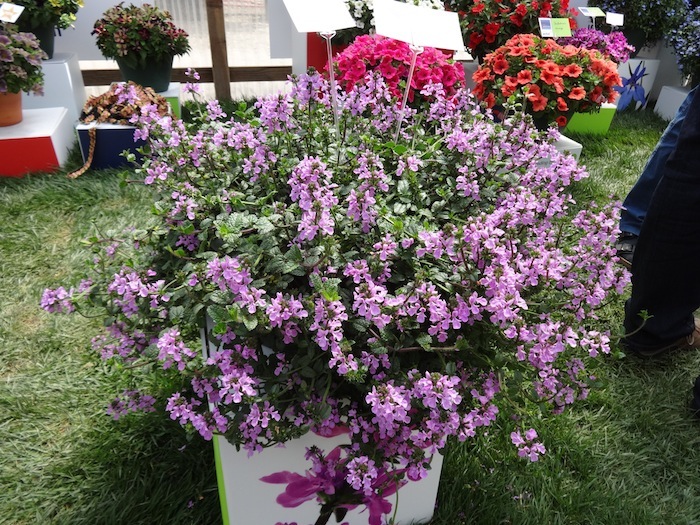
Perennial Solutions: Stachys ‘Lilac Falls’
What can make a great perennial better? Cross it with another great perennial. That’s exactly what breeders did with stachys ‘Lilac Falls’. Although it’s listed as stachys, ‘Lilac Falls’ is a new intergeneric hybrid cross between stachys and lamium.
This new perennial has all of the characteristics required to ensure consumer success. It’s easy to grow and care for and is being touted for its toughness, withstanding the stresses of heat, humidity and cold.
In the landscape, ‘Lilac Falls’ is a colorful, long-blooming groundcover. For garden centers, it makes a great component or standalone plant in hanging baskets and works well as a cascading plant in combination planters. It produces an abundance of beautiful lilac lavender flowers and blooms continuously from early spring through autumn.
Stachys ‘Lilac Falls’ is hardy to USDA Hardiness Zone 5 and can be grown in locations with full sun to partial shade. It grows 8-12 inches tall and spreads 20-36 inches across. With its flower power and extended bloom time, ‘Lilac Falls’ is one perennial growers, landscapers and gardeners will surely fall in love with.
Propagation
Stachys ‘Lilac Falls’ is a patented plant and is vegetatively propagated by licensed propagators; propagation without a license is prohibited. Licensed propagators can easily propagate ‘Lilac Falls’ when following a few guidelines.
The cuttings should be stuck into moistened media or stabilized growing media. Stachys generally root easily without using rooting compounds; however, spraying them with 500- ppm IBA after sticking will improve the uniformity of rooting. The cuttings require medium amounts of misting during the first few days they are in propagation. Maintain soil temperatures of 70 to 74º F during the rooting process.
After the first few days, slightly reduce the amount of mist being provided. Fertilizers can be applied continuously with the mist water at 50- to 60-ppm nitrogen or every five to seven days applying 100- to 120- ppm nitrogen every five to seven days with each irrigation.
Continue to decrease the amount of mist being delivered as the roots begin to develop; misting can generally be removed altogether 10 to 14 days after sticking. It is recommended to pinch the cuttings one to two weeks after the misting has been removed to promote branching. It takes approximately four to five weeks from sticking for the liners to become fully rooted and ready for transplanting.
Production
With its cascading habit, ‘Lilac Falls’ is not suitable for production in traditional trade containers. Rather, it can be grown in intermediate container sizes, such as 4- to 5-inch pots, which can be used for transplanting into larger containers or baskets, or ‘Lilac Falls’ can be planted directly into large containers or baskets. Typically, growers transplant one liner per pot when growing them in small container sizes or multiple liners into baskets or large containers, such as three liners per 10-inch basket.
Stachys prefers to be grown in a well-drained growing mix. They require an average amount of irrigation and do not tolerate overly dry growing conditions; do not allow excessive drying out. When irrigation is necessary, water them thoroughly then allow the soil to dry slightly between waterings.
‘Lilac Falls’ has a great branching habit and may not require pinching. If the liners were not pinched before transplanting or if additional branching is desired, the plants can be pinched one to two weeks after planting.
It has a moderate fertility requirement. Nutrients can be provided using water-soluble fertilizers by delivering 150-ppm nitrogen plus micronutrients with each irrigation or 250-ppm nitrogen as needed. Fertility can also be delivered using controlled release fertilizers by incorporating the equivalent of 0.9 to 1.1 pounds of elemental nitrogen per cubic yard of growing into the growing mix before planting or topdressing using the medium labeled rate. Maintain the growing mix throughout the production cycle with a pH between 5.8 and 6.2. To improve the coloration of the foliage, it is beneficial to provide supplemental iron.
The best growth attributes are obtained when they are grown under high light intensities; low light levels lead to stem elongation and legginess. The highest plant quality is achieved when they are grown outside under natural light intensities. Due to its cascading habit, it is not necessary to use plant growth regulators.
Insects and Diseases
There are only a few pests and diseases that have been observed on Stachys ‘Lilac Falls’. Aphids, spider mites and whiteflies are the most prevalent insect pests. Growers may observe root rot pathogens on occasion, especially following periods of drought stress or extended periods of overly wet conditions. Generally, it is not necessary to implement preventative management strategies for any of these insects or diseases. The occurrence of these problems can be detected with routine crop monitoring and control strategies implemented if necessary.
Temperature and Scheduling
It is easy to grow flowering plants of Stachys ‘Lilac Falls’. To my knowledge, the exact requirements for flowering have not been researched. However, growers have learned that no vernalization is required for flowering and ‘Lilac Falls’ appears to be a long-day beneficial plant.
In most instances, growers are growing it as a first-year flowering perennial where they plant and sell it during the same growing season. When they are grown with 24-hour average temperatures at 65-68° F, it will take approximately five to six weeks to finish 1-quart containers. Allow eight to 10 weeks for 10-inch baskets.
Availability
Stachys ‘Lilac Falls’ is brought to the industry by Westflowers. There will likely be a limited supply of rooted liners available over the next couple of years. Some of the licensed propagators include Gulley Greenhouse (www. gulleygreenhouse.com), D.S. Cole Growers (www.dscolegrowers.com) and Mast Young Plants (www. mastyoungplants.com).


 Video Library
Video Library 




















